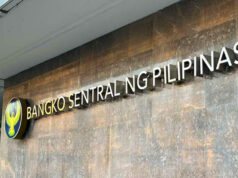Banks post bigger returns, capital buffers but slower asset, loan growth
By Christine Joyce S. Castañeda
Senior Researcher
THE COUNTRY’s biggest banks saw their profitability and capacity to absorb risky assets improve in the first quarter, even as asset and loan growth eased.
The first quarter edition for this year of BusinessWorld’s Quarterly Banking Report shows the combined assets of 46 universal and commercial banks (U/KBs) grew 10.91% to P16.66 trillion in the January-March period from P15.02 trillion in the same three months last year.
The first-quarter asset growth was slower than the 11.4% recorded in the fourth quarter of 2018 and 11% in 2018’s first quarter.
Bank loans, which made up around 54.4% of big banks’ assets last quarter, totaled P9.06 trillion, up 12.4% from last year’s P8.07 trillion. This is slower than the 15.1% year-on-year loan growth in 2018’s last quarter and the year-ago 17.8%.
In terms of profitability, the median return on equity (RoE) improved to 8.1% from 5.4% in the fourth quarter and 5.1% in 2018’s comparable three months. RoE, which is the ratio of net profit to average capital, measures how well a company makes use of the money from shareholders to generate income. Put another way, it measures the amount that shareholders make on every peso they invest in a company.
BDO Unibank, Inc. (BDO) continued to have the most assets among U/KBs, followed by Metropolitan Bank & Trust Co. (Metrobank) and the Bank of the Philippine Islands (BPI).
BDO issued the most loans at P1.97 trillion. BPI displaced Metrobank in second place in terms of loans, with the former having P1.34 trillion, and the latter, P1.33 trillion.
Among banks with assets of at least P100 billion, China Banking Corp. posted the fastest asset growth of 23.5% year-on-year. It was followed by Philippine National Bank’s 20.6% growth and East West Banking Corp.’s 17.7%.
The first three months saw Bank of Commerce as the most aggressive lender, with a year-on-year growth of 27.6%, followed by Development Bank of the Philippines with 26.6% and Robinsons Bank Corp. with 23.8%.
In terms of deposits, BDO remained on top with P2.36 trillion. Land Bank of the Philippines came in second at P1.68 trillion, followed by BPI’s P1.61 trillion.
ASSET QUALITY
Meanwhile, the banks’ median capital adequacy ratio — or the ability to absorb losses from risk-weighted assets — improved to 18.8% in the first quarter from the previous quarter’s 17.9% and the past year’s 18.2%.
The ratio remains well above the regulatory minimum of 10% set by the Bangko Sentral ng Pilipinas as well as the international standard of eight percent.
Nonperforming asset ratio — nonperforming loans and foreclosed properties in proportion to total assets — rose to 0.7% from 0.6% in the preceding quarter.
On the other hand, nonperforming loan (NPL) ratio of the biggest banks worsened to 1.53% from 1.45% three months prior.
As percent of total assets, foreclosed real and other properties roughly steadied at 0.3% in the first quarter.
Banks’ coverage ratio — the ratio of the total loan loss reserves to gross NPL — was 117.7% during the quarter. This was lower than the 130.6% in the preceding three months but still more than enough to cover the entire value of bad loans held by the country’s big banks, with loan loss reserves totaling P158.34 billion.
Since 1987, BusinessWorld has been tracking the quarterly performance of the country’s largest lenders based on their published statements of condition.
The quarterly banking report ranks banks in terms of size of their balance sheet and presents other key ratios used in measuring bank performance, such as capital adequacy, earnings and liquidity.
This issue marks the entry of Industrial and Commercial Bank of China, Ltd.-Manila Branch to the list after starting operations on Feb. 14.



